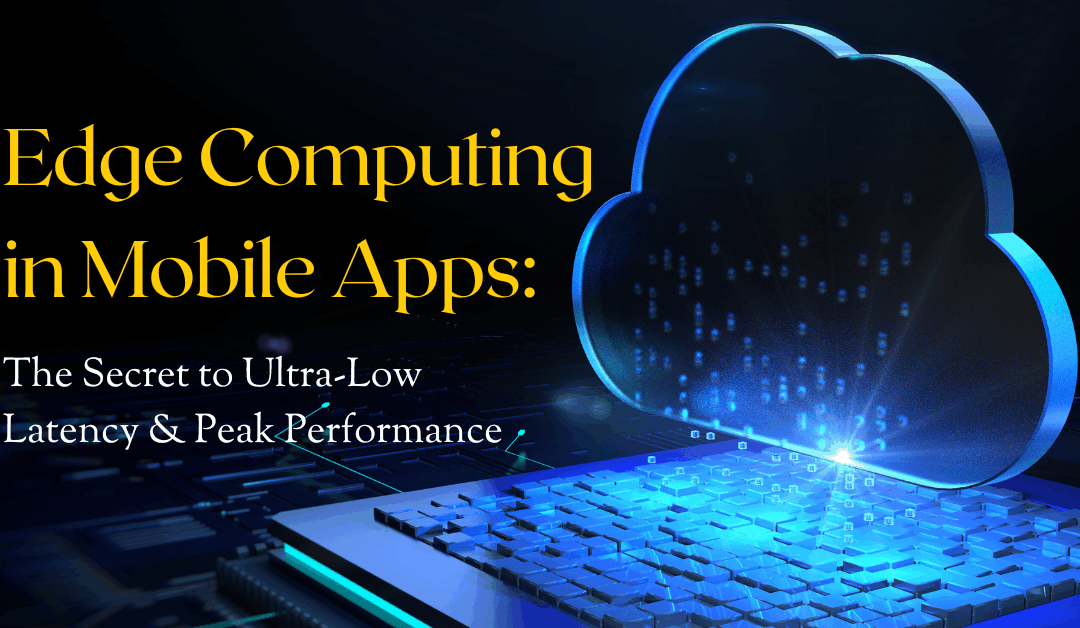Edge Computing in Mobile Apps: Reducing Latency and Enhancing Performance
We’ve all been there. You tap a button on your mobile app, and… you wait. That spinning wheel, that loading bar—that’s latency. In today’s fast-paced digital world, a delay of even a single second can lead to user frustration and app abandonment. The culprit is often the distance data must travel from your phone to a centralized cloud server and back again.
But what if the processing didn’t happen thousands of miles away? What if it happened right near you?
This is the central promise of Edge Computing in Mobile Apps. It’s a revolutionary approach that is fundamentally changing how we build and experience mobile applications, moving us from a world of “wait-and-see” to “see-it-now.”
What is Edge Computing?
Think of the traditional cloud like a massive central bank vault (like Fort Knox). To make any transaction, your request has to travel all the way to this one, highly secure, massive location, get processed, and then the result has to travel all the way back. This is powerful and secure, but it’s slow.
Edge Computing is like building a network of local bank branches and smart ATMs.
For instant needs—like withdrawing cash or checking your balance—you go to the local ATM (the “edge”). The request is handled right there, instantly. For massive, complex operations—like applying for a mortgage—the ATM might securely bundle your info and send it to the central vault (the “cloud”) for heavy-duty processing.
Edge computing doesn’t replace the cloud; it works with it. It processes time-sensitive data locally (on the device or a nearby server) and sends only the most important data to the central cloud for long-term storage or big-data analysis.
The Key Benefits of Edge Computing in Mobile Apps
Integrating this “local processing” model has transformative benefits for mobile users and developers alike.
- Drastically Reduced Latency (The Speed Factor)
This is the number one benefit. Latency is the time it takes for data to travel. By processing data at the edge, we cut the travel distance.
- Real-World Impact: For a mobile AR game, this means an augmented object appears “locked” to the real world instantly. In a live-streaming app, it eliminates the awkward delay between the streamer and the chat.
- Enhanced Performance and Real-Time Response
When latency drops, performance skyrockets. Apps feel snappy, fluid, and “real.” This is essential for any application that relies on immediate feedback.
- Example: Edge AI: Think of the live camera filters on your phone. The AI that tracks your face and applies the filter has to run locally. If it were sent to the cloud, you’d move your head, and the filter would lag a second behind. Edge Computing in Mobile Apps makes this real-time AI possible.
- Improved Reliability and Offline Functionality
What happens when your mobile connection is spotty or drops completely? A cloud-reliant app simply stops working. An edge-enabled app can continue to perform its core functions by processing data locally.
- Example: Retail Apps: A cashier’s mobile point-of-sale (POS) system can continue to process transactions locally during an internet outage and sync them to the central cloud once the connection is restored.
- Enhanced Privacy and Security
Sending all user data to a central cloud increases risk. Every piece of data sent over the internet is a potential target.
- Example: Health Apps: A mobile health app can use edge computing to analyze a user’s heart rate or sleep patterns directly on their device. Only the anonymized, summarized result (e.g., “User’s average resting heart rate was 65 bpm”) is sent to the cloud, not the raw, sensitive biometric data.
- Reduced Bandwidth and Data Costs
Video, audio, and AI data are heavy. Constantly uploading and downloading this data from the cloud eats up a user’s mobile data plan and costs developers a fortune in server fees. Edge computing pre-processes this data, sending only the small, relevant bits to the cloud.
Edge vs. Cloud: A Powerful Partnership
It’s a common misconception that edge computing is here to replace the cloud. The truth is, they work best together.
- The Cloud is for:
- Massive data storage
- Training complex AI models
- Heavy-duty, non-urgent batch processing
- Centralized user account management
- The Edge is for:
- Instant data processing and filtering
- Real-time AI (inference)
- Immediate user interactions
- Making apps work in low-connectivity areas
A truly smart app uses both. The future of mobile development isn’t “Cloud vs. Edge”; it’s a hybrid model that leverages the best of both worlds. This strategic use of Edge Computing in Mobile Apps is what separates a good app from a great one.
The Future is Fast: 5G and the Rise of the Edge
The rollout of 5G is the single biggest catalyst for edge computing. 5G provides the ultra-fast, high-bandwidth “road,” but it doesn’t solve the “distance” (latency) problem on its own.
5G + Edge Computing is the perfect match. 5G allows us to get massive amounts of data from the device to the nearest edge server in milliseconds. Together, they will unlock the next generation of mobile experiences:
- Truly immersive, multiplayer AR/VR.
- Connected cars that communicate with each other instantly.
- Real-time holographic video calls.
Frequently Asked Questions (FAQ)
Q1: What is the main difference between edge computing and cloud computing for mobile apps?
The main difference is location. Cloud computing processes data in large, centralized data centers far from the user. Edge computing processes data “at the edge” of the network, either on the mobile device itself or on a local server (like a 5G tower) that is physically close to the user.
Q2: Is Edge AI the same as Edge Computing?
Edge AI is a use case of edge computing. It refers to running artificial intelligence (AI) models directly on an edge device (like a smartphone) rather than in the cloud. This is what allows for real-time camera filters, live language translation, and “Hey Siri” voice commands.
Q3: Does edge computing make mobile apps more secure?
Yes, it can significantly improve security and privacy. By processing sensitive user data (like biometrics or location) on the device itself, that data never has to be sent over the internet to a cloud server, where it could be intercepted or exposed in a data breach.
Conclusion: Why You Can’t Ignore the Edge
The demand for instant, intelligent, and reliable mobile experiences is only growing. The old model of sending everything to a distant cloud is no longer good enough for the next generation of applications.
To reduce lag, boost performance, and delight users, developers must think locally. The future of mobile development and a superior user experience lies in the smart implementation of Edge Computing in Mobile Apps. It’s not just a technical upgrade; it’s the new standard for building apps that feel truly alive.

